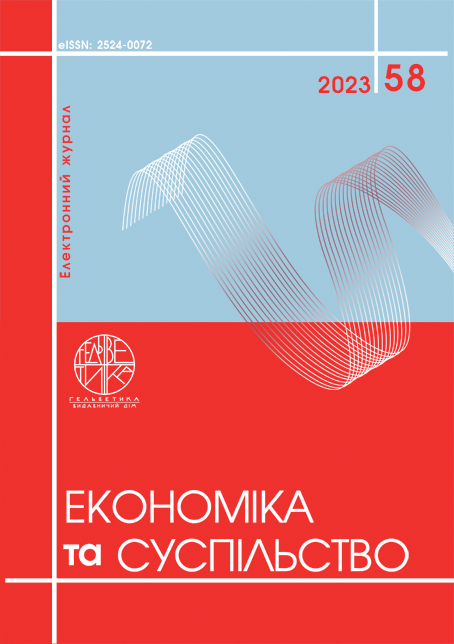MODEL FOR ASSESSING THE READINESS OF THE COMPANY FOR THE IMPLEMENTATION OF BLOCKCHAIN TECHNOLOGIES
Abstract
The article aims to develop a model for assessing companies' readiness to implement blockchain technologies, taking into account factors that influence this process. To achieve this, a model is proposed that considers the current level of a company's knowledge about blockchain technologies and three groups of factors, namely: technological, organizational, and external environmental factors. The three identified groups of factors offer a structured way to analyze the readiness of a company from different perspectives. The article suggests a set of factors for each of the three identified groups. The technological factors encompass aspects related to the development of blockchain technologies and understanding of adventages of technologies within the organization. Organizational factors that take into account the internal structure and processes of the company, leadership commitment, organizational culture, and the availability of dedicated teams for blockchain implementation. External environmental factors involve considerations beyond the company's immediate control, such as regulatory frameworks, market trends, and potential collaborations with external partners. These factors can significantly impact the feasibility and success of blockchain implementation. It is also necessary to determine the weight coefficients for each factor and each group of factors to construct an integrated indicator. To accomplish this, the article proposes using the Analytic Hierarchy Process (AHP) method. This enhances the precision and objectivity of the evaluation process, providing companies with a more reliable basis for decision-making. In general, the approach to assessing companies' readiness for blockchain technology implementation proposed in the article can be a valuable tool for companies considering the possibility of integrating blockchain into their operations. By considering a range of factors and utilizing a systematic methodology, it provides valuable insights that can guide companies in making informed decisions about integrating blockchain into their operations.
References
Barnes III, Bruce W. and Xiao, Bo, "Organizational Adoption of Blockchain Technology: An Ecosystem Perspective" (2019). DIGIT 2019 Proceedings. 9. https://aisel.aisnet.org/digit2019/9
Beck, R. Technology-driven changes in the economy. In The Routledge Companion to Management Information Systems; Routledge Falmer: Abingdon, UK, 2017. [Google Scholar]
Bocek, T., Rodrigues, B. B., Strasser, T., and Stiller, B. (2017). “Blockchains Everywhere - a Use-Case of Blockchains in the Pharma Supply-Chain,” in 2017 IFIP/IEEE Symposium on Integrated Network and Service Management (IM), Lisbon, May 8–12, 2017 (Lisbon, Portugal: IEEE), 772–777. doi:10.23919/INM.2017.7987376
Choi, D., Chung, C. Y., Seyha, T., and Young, J. (2020). Factors Affecting Organizations' Resistance to the Adoption of Blockchain Technology in Supply Networks. Sustainability 12, 8882. doi:10.3390/su12218882
Deloitte’s 2019 Global Blockchain Survey | Deloitte Insights. Cambridge, United Kingdom: Deloitte Development LLC. Available at: https://www2.deloitte.com/content/dam/Deloitte/se/Documents/risk/DI_2019-global-blockchain-survey.pdf.
Iansiti, M.; Lakhani, K.R. The Truth about Blockchain. Available online: https://hbr.org/2017/01/the-truth-about-blockchain (accessed on 21 August 2019).
Kamble, S., Gunasekaran, A., and Arha, H. (2019). Understanding the Blockchain Technology Adoption in Supply Chains-Indian Context. Int. J. Prod. Res. 57, 2009–2033. doi:10.1080/00207543.2018.1518610
Klaus D. Goepel, (2013). Implementing the Analytic Hierarchy Process as a Standard Method for Multi-Criteria Decision Making In Corporate Enterprises – A New AHP Excel Template with Multiple Inputs, Proceedings of the International Symposium on the Analytic Hierarchy Process, Kuala Lumpur 2013. DOI: https://doi.org/10.13033/isahp.y2013.047
Lustenberger M, Malešević S and Spychiger F (2021) Ecosystem Readiness: Blockchain Adoption is Driven Externally. Front. Blockchain 4:720454. doi: 10.3389/fbloc.2021.720454
Nakamoto, S. Bitcoin: A Peer to Peer Electronic Cash System. Available online: https://bitcoin.org/bitcoin.pdf (accessed on 20 March 2018).
Saaty, T. L. (1980). The Analytic Hierarchy Process, Planning, Priority Setting, Resource Allocation. Mc Graw-Hill, NY 1980
Saaty, T. L. (2003). Decision making with AHP: Why is the principal eigenvector necessary. European Journal of Operational Research 145, 85-91
Tapscott, D., and Tapscott, A. (2016). Blockchain Revolution: How the Technology behind Bitcoin Is Changing Money, Business, and the World. New York: Penguin.

This work is licensed under a Creative Commons Attribution 4.0 International License.


